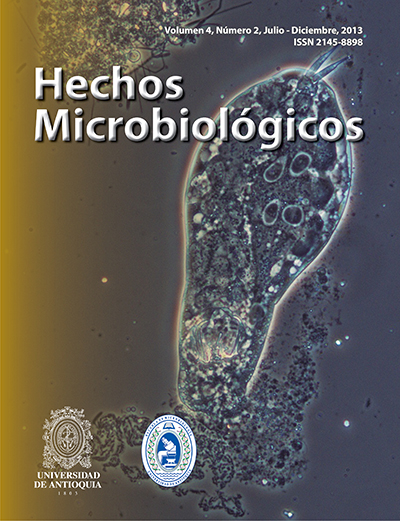Producción de bioetanol empleando fermentación tradicional y extractiva a partir de jugo de fique
DOI:
https://doi.org/10.17533/udea.hm.21090Palabras clave:
bioetanol, jugo de fique, fermentación alcohólica, fermentación extractivaResumen
El fique (Furcraea sp.) es una planta nativa de Colombia, de la cual se extrae sólo un 4% de fibra natural y el otro 96% lo componen el jugo y los bagazos. El jugo de fique contiene aproximadamente 9,71, 28,74 y 13,51 g/L de sacarosa, fructosa y glucosa respectivamente, azúcares que son aprovechados por algunos microorganismos para la producción de bioetanol. En este trabajo se realizó la fermentación alcohólica empleando dos microorganismos seleccionados, Clavispora lusitaniae, aislada del jugo de fique, y Saccharomyces cerevisiae, durante 48 h, a 25°C y a un pH de 4,4, obteniéndose 10,68 g/L y 5,26 g/L de bioetanol respectivamente. La temperatura más adecuada para realizar el proceso fermentativo de jugo de fique fue de 30°C, obteniéndose 12,3 g/L de bioetanol con Clavispora lusitaniae a las 48 h de fermentación, produciéndose un 103% más bioetanol que la obtenida con Saccharomyces cerevisiae. En la fermentación extractiva empleando Clavispora lusitaniae durante 48 h a 30ºC y a un pH de 4,4, se obtuvieron 7,87 g/L de bioetanol, 6,75 g/L en la fase acuosa y 1,12 g/L en la fase oleosa, un 35% menor que al utilizar fermentación tradicional.
Descargas
Citas
Siqueira P, et al. Production of bio-ethanol from soybean molasses by Saccharomyces cerevisiae at La-boratory, pilot and industrial scales. En: Bioresource Technology. Vol. 99, No.17. 2008; p. 8156-63.
Cheng H, Wang F. Optimal process/solvent design for ethanol extractive fermentation with cell re-cycling. En: Biochemical Engineering Journal. Vol.41, No.3. 2008; p. 258-65.
Murray D. El potencial del etanol: mirando más allá del maíz 2005 http://www.terra.org/arti-culos/art01335.html
Ministerio de Ambiente.Guía ambiental del sub-sector fiquero. 2a Ed. Bogotá (Colombia). 2006; 128 p.
Karunanidhi, Anuradha. Extractive Fermentation of Ethanol in an aqueous two-phase system bySaccharomyces cerevisiae NCIM 3288. Advanced Bio-tech, Vol. 11. 2008; p.11-5.
Boudreau T, Hill G.Improved Ethanol-water separa-tion using fatty acids. En: Process Biochemistry 41; 2006.
Rivera E, et al.Evaluation of optimization techni-ques for parameter estimation: Application to etha-nol fermentation considering the effect of tempera-ture. En: Process Biochemistry 41. 2006; p.1682-7.
APHA. Standard methods for the examination of wa-ter and wastewater. 20th ed. Washington DC: Ameri-can Public Health Association. 1998.
Pretorius I, et al.Designer Yeasts for the Fermenta-tion Industry of the 21st Century. En: Food Technol. Biotechnol. 2003; 41(1). p.3-10.
Lloret S, Carmina, Gutiérrez U, Olivia, Borrell S, Nuria. Candida lusitaniae. http://www.seimc.org
González A, Valenzuela L.Saccharomyces Cerevi-siae. México http://www.microbiologia org.mx/microbiosenlinea/CAPITULO_20/Capit-ulo20.pdf.
Sánchez O, Cardona.Producción biotecnológica de alcohol carburante I: A partir de diferentes materias primas. En: Interciencia. 2005; p. 671-7.
Conrad J, et al. A novel furostanol saponin from Tríbulus terrestris of Bulgarian origin. In: Fitoterapia, Vol.75, No.18. 2004.
Sliwinski B, et al.Efficacy of plant extracts rich in secondary constituents to modify rumen fermen-tation. In: Animal Feed Science and Technology, Vol.101, No. 23. 2002.
Jeffries TW, Alexander MA.Production of ethanol from xylose by Candida shehatae grown under con-tinuos or fed-batch conditions. En: Biotechnology in pulp and paper manufacture. http://www.fpl.-fs.fed.us/documnts/pdf1990/jeffr90a.pdf. .
Freer S, Greene R.Transport of Glucose and cello-biose by Candida wickerhamii and Clavispora lusita-niae. The Journal of Biological Chemistry, Vol. 265, No. 22, August 5, 1990, p.12865.
Treybal R. Operaciones de transferencia de masa, 2aEd. Mc Graw-Hill, México 1988; 858 p.
Offeman R, et al.Extraction of ethanol with higher alcohol solvents and their toxicity to yeast. Separation and Purification Technology 63. 2008; p. 444-451.
Kutluo O, et al.Bioconversion of starch into etha-nol by a recombinant Saccharomyces cerevisiae stra-in YPG-AB. En: Process Biochemestry. Vol.37, No.10. 2002; p.1157-68.
Linde M, Galbe M, Zacchi G.Simultaneous saccha-rification and fermentation of steampretreated barley Straw at low enzyme loadings and low yeast concen-tration. En: Enzyme and Microbial Technology. Vol.40, No.5. 2007; p.1100-7.








